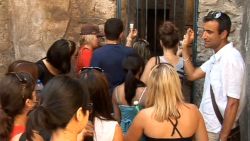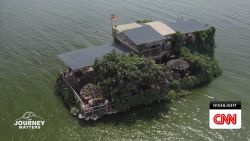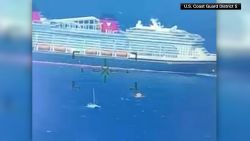It’s barely a speck on the map.
If you don’t look too closely at the skinny wooden pier or the thatched-roof dwellings dotting the shoreline, you might mistake it for just another village, on just another island, and sail on.
After all, there are more than 7,000 islands in the Philippines. But Ariara is different. And it happens to be my destination, after an hour by plane from Manila, another by road, and two hours on the Maya Maya, a luxury catamaran.
For the next couple of days, its 125 acres of pristine beach, forest and rocky coastline, rising out of the coral-filled azure waters, are all mine.
Their own version of paradise
Well, technically, they belong to the couple waiting for me on the pier: Charlie and Carrie McCulloch, property developers and farmers from Berkshire, England.
“There are not very many places like this,” says Charlie, explaining what drew them halfway around the world.
“But it was always my idea of perfection.”
The idea was simple, the McCullochs tell me over a white table-clothed al fresco lunch – to take the best of every vacation they had experienced and to create their own version of paradise.
Ariara would be a vacation home for them and their three sons, though chiefly it would be a business: one where a single party of up to 18 guests at a time would take over the island and its staff, for a week or more at a time, and enjoy it as their own.
Resorts where you rent a villa, even at the high-end, just weren’t good enough for what they envisioned, the McCullochs say.
The luxury island you can rent for $60,000
There was always a feeling of being “processed,” and of not feeling completely at home.
“Even if you have a beautiful suite in a hotel, or a villa in a resort, ultimately, you have to turn the music down!” Carrie quips.
“And here?” I ask.
“You can have it as loud as you want!”
While the idea seemed simple, the reality of creating the ultimate retreat in this remote, unspoiled stretch of the Philippines far from where tourists venture was much more complicated.
There was the issue of leasing the land from the government, the logistical nightmare of getting raw materials and fuel to the island and the challenge of finding and training builders and craftsmen, many of them local fishermen from neighboring islands.
“Most people would have given up,” Carrie admits.
Your choice of retreat
After a tasty lunch of gazpacho and freshly grilled fish – caught that very morning, I’m told – Charlie takes me for a tour of Ariara.
There’s the Lodge, a central gathering place filled with cream-colored sofas, and an octagonal dining room with an enormous round table that looks like it could seat two dozen, all open to the sea breeze.
And just down the garden pathways, your choice of personal luxury retreat: Beach Cottage complete with a hammock on the front verandah, or, if you prefer, elevated Jungle Villas with a view of the water from bed and a private outdoor bath in back overlooking the forest.
They’ve been open for business for about four years, Charlie explains, but the McCullochs aren’t normally here when guests arrive.
Having them around would take away from the authenticity of having your own private island.
Instead, Charlie and Carrie work out the details with one “lead guest” from each group ahead of time: everything from the menus to special requests like an onsite yoga instructor or cases of a favorite champagne.
I’m curious to know who these guests are and what they get up to when they borrow this piece of paradise for a few days.
After all, not everyone can afford to spend $500 per person, per night (alcoholic beverages and fuel for Ariara’s 12 boats not included).
Depending on the number of guests, a week’s stay costs between $30,000 and $60,000.
But my hosts are tight-lipped, revealing only that they come from places such as the UK, Australia, China and South Korea, and that many of them are returning for the second, third or even fourth time.
Still, they do need more guests, Charlie concedes.
But he insists that even with the island booked only about one-third of the time, the business is sustainable and profitable.
Anything is possible
It takes a couple of days for it all to sink in.
In that time, I get wind-blown on the Hobie Cat, expertly piloted by Captain Johnny and Eric, both former fishermen and part of Ariara’s staff of 30, many of whom do at least two or three different jobs.
And I snorkel just offshore with island manager Florian Muller, where I spot a two-meter black-tipped reef shark, and promptly decide I’ve had enough wind and water, and climb back into the speedboat.
The McCullochs also insist that I take on the role of “lead guest,” selecting menus and locations for cocktails and meals, though the gusty wind at the end of the pier forces us to retreat to the dining room halfway through a candlelit dinner one night.
I also remain acutely aware that any last-minute special requests would require a shipment from their supplier in Manila. Anything is possible, I’m told, but I don’t want to be unreasonable.
I could get used to this, I think. But before I realize it, it’s time to go.
More guests are on the way, Charlie tells me as we walk down the beach one last time. Ever-the-discerning host, he won’t give away who they are or where they’re from.
Beyond getting more business, I ask, what does he hope Ariara will become five or 10 years from now?
“It needs to stay in my mind, exactly the same concept,” Charlie answers. “Which is untouched, unspoiled.”
Ariara can be reached via a short helicopter ride or a domestic flight from Manila, followed by a boat transfer. Contact information available on the island’s website.
Heritage and hilarity: Funnyman’s mission to save Old Manila





















